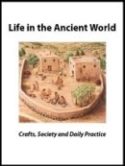While you won’t find wild ostriches in Israel today, in ancient times an ostrich egg breakfast would not have been that out of place. Indeed, the Israel Antiquities Authority (IAA) has announced the discovery of a collection of ostrich eggs at a nomadic campsite in the Negev Desert, dated between 4,000 and 7,500 years ago.

Fried or Scrambled?
The eight ostrich eggs were uncovered during a salvage excavation by the IAA near the town of Be’er Malka, on the Egyptian border. In the course of excavation, the team uncovered an ancient nomadic camp, measuring roughly 2,000 square feet. “At the site we found burnt stones, flint and stone tools as well as pottery sherds, but the truly special find is this collection of ostrich eggs,” said excavation director Lauren Davis. “The proximity of the group of eggs to the fire pit indicates that this is not a natural chance find but the intentional collecting of the eggs.”
“The ostrich eggs were crushed but well-preserved, despite the fact that they were uncovered in the surface layer,” Davis said. “These camp sites were quickly covered over by the dunes and were re-exposed with the sand movement over hundreds and thousands of years. This fact explains the exceptional preservation of the eggs, allowing us a glimpse into the lives of the nomads who roamed the desert in ancient times.”
While wild ostriches have been extinct outside of Africa since the early-to-mid 20th century, in ancient times they were right at home in the southern Levant and northern Arabia. Indeed, ostrich eggs have been found in a number of archaeological excavations, although this discovery may be the oldest. According to Amir Gorzalczany of the IAA, who studies the subject, “We find ostrich eggs in archaeological sites in funerary contexts, and as luxury items and water canteens. There is sometimes even evidence of decorating and incising on ostrich eggs, showing their use as decorative items.”
Interestingly, however, the discovery of ostrich bones in archaeological contexts is quite rare. As accounted by Gorzalczany, this might be evidence that while the eggs were a valuable source of protein (the equivalent of about 25 modern chicken eggs), the birds themselves were rarely hunted given how speedy and difficult they are to hunt.
Although the nomadic nature of the Negev site makes it difficult to precisely date the ostrich eggs, the site’s pottery, flints, and other finds all date from the Chalcolithic period (c. 4500–3300 BCE) to the Middle Bronze Age (c. 2000–1550 BCE). This has provided a rough estimate as to the age of the eggs, although it is hoped that further laboratory analysis will provide a more specific date. “After the excavation, we will reconstruct the eggs, just like a puzzle. The whole egg may tell us the species, and exactly what they were used for. As far as I’m concerned, every eggshell is worth its weight in gold,” said Davis.
Today, wild ostriches are found only in Africa, but they roamed portions of the eastern Mediterranean and Arabia until the mid-20th century. According to the IAA, ostriches went extinct in Israel in the 19th century. The ostrich is not the only animal that used to be indigenous to the region that is now extinct; other such species include hippopotami, wild horses, bears, and lions. An excavation in southern Israel even uncovered a half-million-year-old elephant tusk.
Read more in Bible History Daily:
All-Access members, read more in the BAS Library:
Animals of the Bible: Living Links to Antiquity
The Biblical Oryx—A New Name for an Ancient Animal
Not a BAS Library or All-Access Member yet? Join today.
The post Ancient Ostrich Eggs Over Easy appeared first on Biblical Archaeology Society.





0 Commentaires